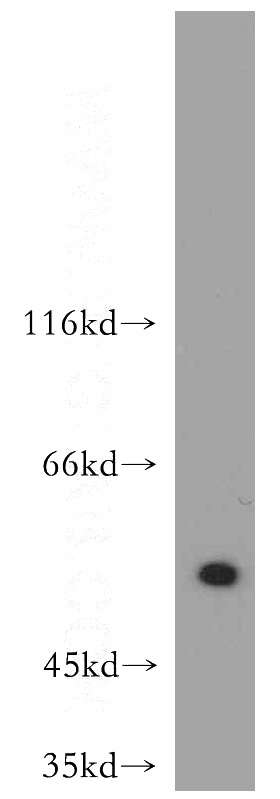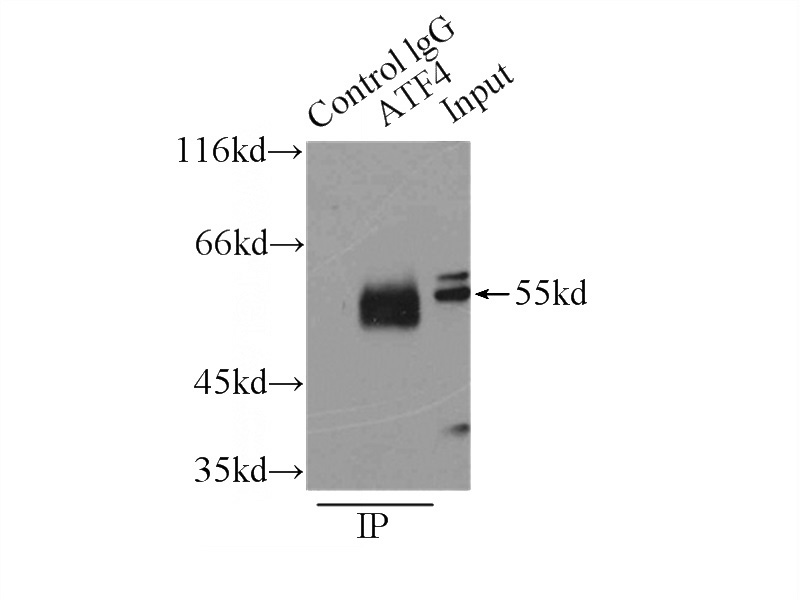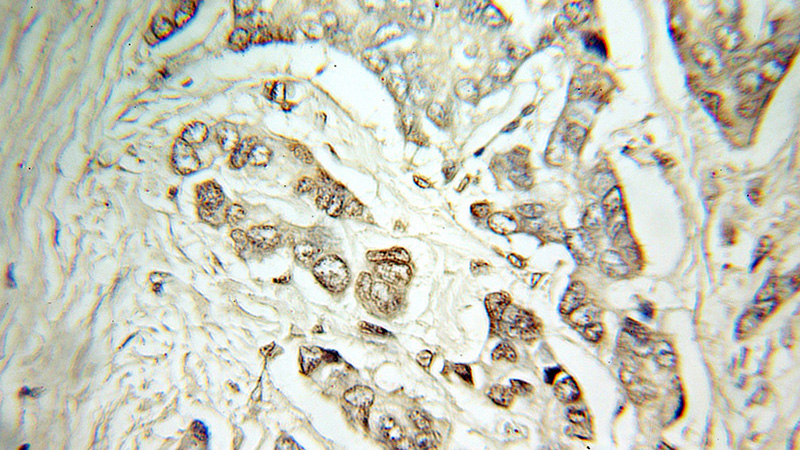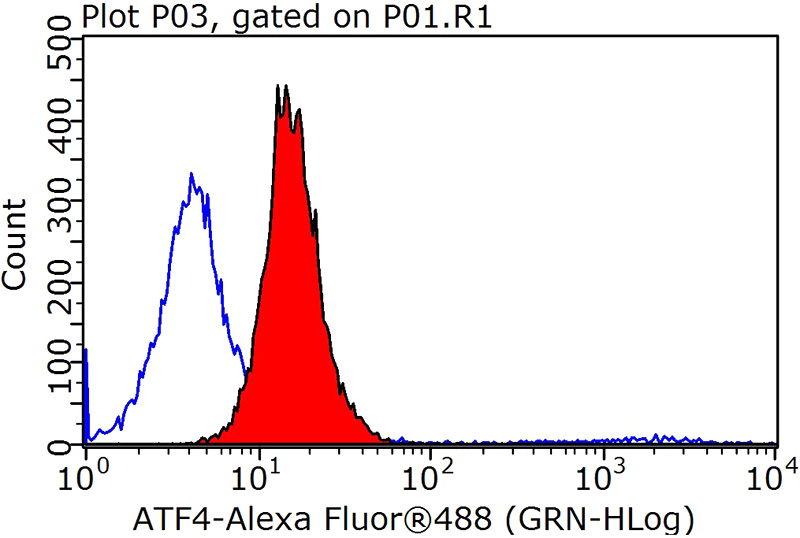-
Product Name
ATF4 antibody
- Documents
-
Description
ATF4 Rabbit Polyclonal antibody. Positive IP detected in HEK-293 cells. Positive WB detected in A431 cells, DU 145 cells, HEK-293 cells, mouse kidney tissue, rat brain tissue, SGC-7901 cells. Positive FC detected in MCF-7 cells. Positive IHC detected in human breast cancer tissue. Observed molecular weight by Western-blot: 50-58 kDa, 35-38 kDa
-
Tested applications
ELISA, WB, IHC, IP, FC
-
Species reactivity
Human,Mouse,Rat; other species not tested.
-
Alternative names
ATF4 antibody; CREB 2 antibody; CREB2 antibody; DNA binding protein TAXREB67 antibody; TAXREB67 antibody; TXREB antibody
- Immunogen
-
Isotype
Rabbit IgG
-
Preparation
This antibody was obtained by immunization of ATF4 recombinant protein (Accession Number: XM_017028807). Purification method: Antigen affinity purified.
-
Clonality
Polyclonal
-
Formulation
PBS with 0.1% sodium azide and 50% glycerol pH 7.3.
-
Storage instructions
Store at -20℃. DO NOT ALIQUOT
-
Applications
Recommended Dilution:
WB: 1:200-1:2000
IP: 1:200-1:1000
IHC: 1:20-1:200
-
Validations

A431 cells were subjected to SDS PAGE followed by western blot with Catalog No:108285(ATF4 antibody) at dilution of 1:500

IP Result of anti-ATF4 (IP:Catalog No:108285, 3ug; Detection:Catalog No:108285 1:400) with HEK-293 cells lysate 6000ug.

Immunohistochemical of paraffin-embedded human breast cancer using Catalog No:108285(ATF4 antibody) at dilution of 1:100 (under 10x lens)

1X10^6 MCF-7 cells were stained with 0.2ug ATF4 antibody (Catalog No:108285, red) and control antibody (blue). Fixed with 90% MeOH blocked with 3% BSA (30 min). Alexa Fluor 488-congugated AffiniPure Goat Anti-Rabbit IgG(H+L) with dilution 1:1000.
-
Background
ATF4 is a transcription factor, that accumulates predominantly in osteoblasts, where it regulates terminal osteoblast differentiation and bone formation[PMID: 19016586]. As a basic leucine-zipper (bZip) transcription factor, ATF4 can regulate amino acid metabolism, cellular redox state, and anti-stress responses. It also regulates age-related and diet-induced obesity and glucose homeostasis in mammals, and has conserved metabolic functions in flies[PMID: 19726872]. Due to its location at chromosome 22q13, a region linked to schizophrenia, ATF4 is considered as a positional candidate gene for schizophrenia[PMID: 18163433]. Otherwise, since ATF4 is induced by tumour microenvironmental factors, and regulates processes relevant to cancer progression, it might serve as a potential therapeutic target in cancer. Endogenous ATF4 protein has a molecular mass of 50kd. [PMID: 17726049]. This antibody is a rabbit polyclonal antibody raised against full length human ATF4 antigen. The antibody recognizes the 38kd ATF4 protein and its phosphorylated forms (50kd).
-
References
- Kawakami T, Inagi R, Wada T, Tanaka T, Fujita T, Nangaku M. Indoxyl sulfate inhibits proliferation of human proximal tubular cells via endoplasmic reticulum stress. American journal of physiology. Renal physiology. 299(3):F568-76. 2010.
- Jin Y, Wang L, Qu S. STAMP2 increases oxidative stress and is critical for prostate cancer. EMBO molecular medicine. 7(3):315-31. 2015.
- Xu D, Su C, Song X. Polychlorinated biphenyl quinone induces endoplasmic reticulum stress, unfolded protein response, and calcium release. Chemical research in toxicology. 28(6):1326-37. 2015.
- Kraus J, Kraus M, Liu N. The novel β2-selective proteasome inhibitor LU-102 decreases phosphorylation of I kappa B and induces highly synergistic cytotoxicity in combination with ibrutinib in multiple myeloma cells. Cancer chemotherapy and pharmacology. 76(2):383-96. 2015.
- Duan H, Li Y, Lim HY, Wang W. Identification of 5-nitrofuran-2-amide derivatives that induce apoptosis in triple negative breast cancer cells by activating C/EBP-homologous protein expression. Bioorganic & medicinal chemistry. 23(15):4514-21. 2015.
- Kosakowska-Cholody T, Lin J, Srideshikan SM, Scheffer L, Tarasova NI, Acharya JK. HKH40A downregulates GRP78/BiP expression in cancer cells. Cell death & disease. 5:e1240. 2014.
- Tsukumo Y, Tsukahara S, Furuno A, Iemura S, Natsume T, Tomida A. TBL2 Associates With ATF4 mRNA Via Its WD40 Domain and Regulates Its Translation During ER Stress. Journal of cellular biochemistry. 117(2):500-9. 2016.
- Gao H, Yan P, Zhang S. Chronic alpha-linolenic acid treatment alleviates age-associated neuropathology: roles of PERK/eIF2α signaling pathway. Brain, behavior, and immunity. 2015.
Related Products / Services
Please note: All products are "FOR RESEARCH USE ONLY AND ARE NOT INTENDED FOR DIAGNOSTIC OR THERAPEUTIC USE"
